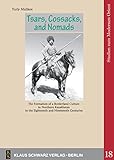Tsars, Cossacks, and Nomads. : The Formation of a Borderland Culture in Northern Kazakhstan in the Eighteenth and Nineteenth Centuries / Yuriy Malikov.
Material type: TextSeries: Studies on Modern Orient ; 18Publisher: Berlin ; Boston : De Gruyter, [2020]Copyright date: ©2020Description: 1 online resource (321 p.)Content type:
TextSeries: Studies on Modern Orient ; 18Publisher: Berlin ; Boston : De Gruyter, [2020]Copyright date: ©2020Description: 1 online resource (321 p.)Content type: - 9783879973958
- 9783112208793
- DK908.75.R8
- online - DeGruyter
- Issued also in print.
| Item type | Current library | Call number | URL | Status | Notes | Barcode | |
|---|---|---|---|---|---|---|---|
 eBook
eBook
|
Biblioteca "Angelicum" Pont. Univ. S.Tommaso d'Aquino Nuvola online | online - DeGruyter (Browse shelf(Opens below)) | Online access | Not for loan (Accesso limitato) | Accesso per gli utenti autorizzati / Access for authorized users | (dgr)9783112208793 |
Frontmatter -- Table of Contents -- Acknowledgements -- Introduction -- Chapter One. Siberian Cossacks and Kazakhs: The Emblems of Identity -- Chapter Two. Cross-Cultural Exchanges on the Frontier: Their Causes and Consequences -- Chapter Three. The Kenesary Kasymov Rebellion (1837–1847): A National-Liberation Movement or ‘a Protest of Restoration?’ -- Chapter Four. The Aims of Russia’s Acquisition of the Steppe -- Chapter Five. The Role of Trade in the Formation of a Frontier Society -- Chapter Six. Conflicts on the Steppe: Their Sources and Resolutions -- Conclusion -- Appendix
restricted access online access with authorization star
http://purl.org/coar/access_right/c_16ec
The book focuses on the relations between Siberian Cossacks and Kazakhs in northern Kazakhstan from the time that it was included into the Russian Empire in 1734 to the end of the nineteenth century. The research aims to demonstrate that extensive contacts between aboriginals of the steppe and newcomers from the north led to the formation of a frontier society, which was distinct from traditional Russian and Kazakh societies. The reciprocal adoptions of diverse cultural elements and cross-cultural exchanges created preconditions for the formation of a 'frontier society of interests', which cross-cut racial and religious barriers, and resisted the attempts of the Russian central government to impose its rule over the peoples of this outlying region. The aforementioned developments challenge the depiction of the contact as 'a battle of cultures' or a meeting of 'two different worlds', as it is typically portrayed in contemporary historiography.
Issued also in print.
Mode of access: Internet via World Wide Web.
In English.
Description based on online resource; title from PDF title page (publisher's Web site, viewed 27. Jan 2023)


